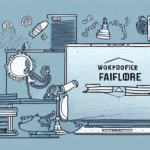Creating a Culture of Continuous Improvement in Operations
In today's rapidly evolving business environment, organizations must adopt a culture of continuous improvement to maintain competitiveness and relevance. This culture encompasses a proactive approach to enhancing processes, fostering innovation, and empowering employees. By integrating continuous improvement into the organizational fabric, companies can achieve sustained growth, increased efficiency, and higher employee satisfaction.
Embracing a Continuous Improvement Mindset
At the core of continuous improvement lies the mindset that change is not only necessary but beneficial. This perspective shifts the focus from maintaining the status quo to seeking incremental and breakthrough improvements.
Leadership Commitment
Leadership plays a pivotal role in cultivating this mindset. Leaders must demonstrate a commitment to continuous improvement by actively participating in training, promoting open communication, and setting clear improvement goals. According to a study by McKinsey & Company, organizations with strong leadership engagement in continuous improvement initiatives are 30% more likely to achieve their strategic objectives.
Employee Engagement
Empowering employees to contribute ideas fosters a sense of ownership and accountability. When team members are encouraged to identify and address inefficiencies, it leads to enhanced job satisfaction and a collective pursuit of excellence.
Key Components of a Successful Continuous Improvement Culture
Building a robust continuous improvement culture requires several foundational elements.
Effective Communication
Transparent communication ensures that all employees understand the goals and processes involved in continuous improvement. Regular updates, feedback sessions, and collaborative meetings facilitate this transparency.
Data-Driven Decision Making
Leveraging data is essential for identifying areas that need improvement and measuring the impact of changes. Tools like Lean and Six Sigma rely heavily on data analysis to drive effective decision-making.
Collaboration and Teamwork
Encouraging collaboration across departments breaks down silos and promotes the sharing of best practices. This collective approach accelerates problem-solving and innovation.
Implementing Effective Continuous Improvement Systems
Adopting structured methodologies helps in systematically pursuing continuous improvement.
Lean Methodology
Lean focuses on eliminating waste and optimizing processes. By identifying non-value-added activities, organizations can streamline operations and enhance efficiency.
Six Sigma
Six Sigma emphasizes reducing process variation and improving quality. Utilizing statistical tools, it helps in identifying root causes of defects and implementing sustainable solutions.
Kaizen
Kaizen promotes incremental improvements through small, continuous changes. This approach engages all employees in the improvement process, fostering a culture of sustained enhancement.
Measuring and Tracking Progress with Metrics
To ensure continuous improvement initiatives are effective, it is crucial to establish and monitor relevant metrics.
Key Performance Indicators (KPIs)
KPIs such as productivity rates, customer satisfaction scores, and revenue growth provide measurable targets that align with the organization's strategic objectives. According to the Harvard Business Review, companies that regularly track KPIs are 50% more likely to outperform their peers.
Regular Reviews and Adjustments
Periodic assessments allow organizations to evaluate the effectiveness of their improvement strategies and make necessary adjustments. This iterative process ensures that initiatives remain aligned with changing business needs and market conditions.
Fostering Employee Engagement and Development
Employees are the driving force behind successful continuous improvement initiatives. Investing in their development and engagement is essential.
Training and Skill Development
Providing continuous training equips employees with the necessary skills to identify and implement improvements. Programs focused on problem-solving, data analysis, and leadership enhance their capability to contribute effectively.
Recognition and Rewards
Recognizing and rewarding employees for their contributions reinforces the value of continuous improvement. Incentives such as bonuses, promotions, and public acknowledgment motivate employees to actively participate in improvement efforts.
Leveraging Technology for Continuous Improvement
Technology plays a critical role in supporting and scaling continuous improvement initiatives.
Data Analytics Tools
Advanced analytics tools enable organizations to gather, process, and analyze large volumes of data. This capability is essential for identifying trends, predicting outcomes, and making informed decisions. Platforms like Tableau and Power BI are widely used for their robust data visualization and analysis features.
Automation and Process Management
Automation tools streamline repetitive tasks, reduce human error, and free up employee time for higher-value activities. Implementing systems like ERP (Enterprise Resource Planning) enhances process management and integration across various departments.
Celebrating Successes and Sustaining Momentum
Recognizing achievements is vital for maintaining the enthusiasm and commitment required for continuous improvement.
Public Recognition
Publicly acknowledging individual and team accomplishments fosters a sense of pride and encourages others to engage in improvement activities. This can be done through awards, newsletters, or company-wide meetings.
Sharing Success Stories
Sharing detailed success stories and best practices across the organization highlights effective strategies and inspires replication. This collective learning accelerates overall organizational improvement.
Maintaining Continuous Momentum
To sustain momentum, it is essential to regularly revisit improvement goals, update strategies based on current data, and continuously engage employees in the improvement journey. This ensures that the culture of continuous improvement remains dynamic and resilient.
In conclusion, establishing a culture of continuous improvement in operations requires a strategic approach that integrates mindset, structured systems, effective metrics, employee development, technological support, and ongoing recognition. By committing to these principles, organizations can achieve long-term success, adaptability, and a significant competitive edge.




















